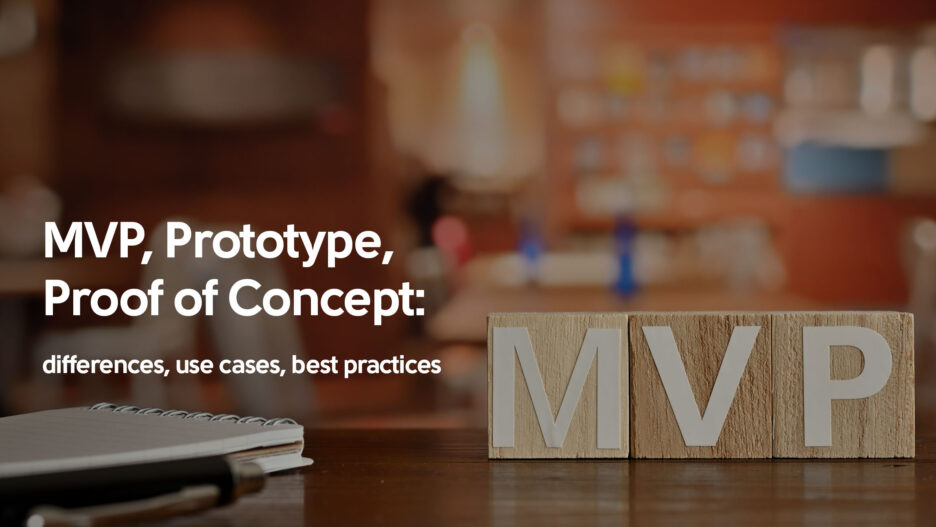New ideas require that you validate how viable and valuable they are. Startups and mature businesses often have a challenging time deciding what’s the best concept to launch a new product line, mostly wondering whether to go with proof of concept, a minimum viable product, or a prototype.
In this article, we take a closer look at each of these concepts to help you decide which one if best for your unique business needs.
What does proof of concept mean?
Proof of concept (POCs) is a core part of sales enablement offerings. According to Gartner’s definition of Proof of Concept, “a proof of concept (POC) is a demonstration of a product, service or solution in a sales context. A POC should demonstrate that the product or concept will fulfill customer requirements while also providing a compelling business case for adoption.”
In the 2020 Gartner Tech CEO Customer Acquisition Survey, it was found that proof of concept or proof of value is the most popular customer acquisition tactic in organizations with more than $250 million in revenue, with 63% leveraging POCs as part of their sales cycles.
Floating around between a minimum viable product and a prototype, POC in software development is essentially the evidence you can show clients from a pilot project to demonstrate a product idea, business plan, or project plan is feasible. For example, proof of concept is widely used in the pharmaceutical industry where clinical trials help show if a final product is viable.
In the proof of concept exercise, organizations also gain valuable information like feedback and insights from contributors and non-contributors about risks or any other element that might jeopardize the viability of a product. In software development, proof of concept helps assess how viable a product or project is before work begins and shows if a product concept is functional and if it can be developed.
What is the minimum viable product (MVP)?
In 2001, Frank Robinson coined the term “minimum viable product (MVP). Fast forward to 2011 when Eric Ries published the book “The Lean Startup” where he pushed the concept and meaning of MVP into the mainstream.
As it gained popularity, we can now find a number of minimum viable “anythings” to signify the lack of pursuit of perfection. For example, minimum viable learning, minimum viable strategy, minimum viable dataset, minimum viable architecture, minimum viable requirements, and more.
There are several layers to the concept of minimum viable product as both enterprise architecture and application leaders use it interchangeably to cover numerous concepts. Ultimately, minimum viable product, or MVP for short, can be thought of as the point when a product has an acceptable number of features or an adequate enough structure to make it possible for clients to meet the expected core needs and deliver outcomes. In short and within this context, a minimal viable product is functional but incomplete.
Here’s Gartner’s definition for MVP: “A minimum viable product (MVP) is the release of a new product (or a major new feature) that is used to validate customer needs and demands prior to developing a more fully-featured product. To reduce development time and effort, an MVP includes only the minimum capabilities required to be a viable customer solution.”
Minimum viable product can also be an adoption threshold, meaning there are enough benefits for the client but just barely. This threshold is usually defined by the client.
The minimum viable product is by no means a destination, but a comfortable pit stop on your way to the end. It is a process of continuous ideation, learning, development, and tracking to evolve and improve a product over time.
Meaning of prototype in software development
In software development, prototypes are a visual representation of a product or a full implementation of a specific feature. Developing a prototype helps developers and designers have a superior experience when interacting with a product user interface and experience. There are different types of prototypes, namely the paper prototype, the horizontal prototype, and the vertical prototype.
A paper prototype refers to the wireframe of a mobile web application that’s built using paper. Paper prototypes help designers understand how a user will interact with an application and figure out which visual elements will need to be a part of it to make the experience engaging and effective.
Horizontal prototypes give designers context about the user experience and interface via interactive wireframes or UI screens with no back-end. Proto.io and Invision are two popular examples of software tools that help create interactive wireframes for the purpose of horizontal prototypes. Horizontal prototypes give designers an outlook of how real users will interact and engage with a software application so they can determine which visual elements need to be included or excluded.
Vertical prototypes are traditionally employed in the final stages of a product analysis exercise as they implement a particular feature across different perspectives, including a user interface and back-end connected to a database to help showcase a specific feature in granular detail.
There’s plenty of prototyping software out there, and as defined by Gartner: “Prototyping software provides tools to create and evaluate early versions of the products and applications before proceeding to the process of production. The software enables the designers to weave visuals, navigational elements, and interactions together to give a representation of the flow and usability of the final product. Prototyping software also allows designers and developers to review the test a prototype, providing feedback and collaborating in real-time to iterate rapidly. Some software also extends to the functionality of integrating with the existing tools in the organization.”
There are also different types of prototyping model types. Namely, there are four different types of prototype models:
- Rapid prototype. What is a rapid prototype? What is the process of fast prototyping? The developer creates a prototype based on early specifications. Rapid prototyping is a quick solution that is then altered in response to customer feedback. Furthermore, each prototype is subject to being discarded and may or may not be included in the final result.
- Evolutionary. It necessitates the development of a continuous, step-by-step prototype. Each prototype is a follow-up to the one before it, with improvements based on user feedback.
- Incremental. The final project concept is broken down into manageable chunks. Each one has a prototype that needs to be created and tested. All of these prototypes are eventually combined into the final product.
- Extreme. This concept is only utilized in the realm of web development. The programmers construct several web prototypes in HTML format with a service layer, all of which are tested and then integrated into the final product.
Advantages of Prototype Model
A prototyping model is an effective means to let clients know about project requirements before the development tasks begin. The advantages of using a prototype model include:
- Flexible design
- Errors are easy to detect
- Missing functionality is easy to spot
- New requirements are easily added
- The model can be easily repurposed in the future for other projects
- Customer satisfaction
- Ideal for online systems
- Deployment channels are selected during the early stages
- User can be involved in the development phase
Disadvantages of Prototype Model
In the model stage of prototyping, a version of the end product is created, tested, and fine-tuned based on customer inputs until an acceptable version of the prototype is reached, thus becoming the foundation to develop the final product. The disadvantages of a prototype model include:
- High costs
- Poor documentation because of changing client requirements
- Too many changing client requirements
- Unrealistic delivery expectations
- Sub-optimal solutions if developers are put in a hurry
- Unsatisfied clients if the product is not what they expected in the initial prototype
- Incomplete or inadequate problem analysis
- Increased system complexity
What to use: MVP/Prototype/Proof of concept
Prototype vs proof of concept is one of the main confusions around. Proof of concept differs from a prototype because, as we stated before, it serves the purpose of demonstrating a product or idea is functional and can be developed. Prototypes actually help visualize how a product will look and function in the real world, showing key software design elements like design, navigation, layout, response, and more.
Prototypes are an early version of the minimum viable product, which contains basic features to give users an idea of what the product is like and what it does. Mainly, POC differs from the software MVP software in the sense that they come at different stages across the software development process and serve entirely different purposes.
The benefits of using a proof of concept:
- Understanding whether or not an idea is feasible
- Exploring the idea’s potential
- Finding risks and bugs that can take place in early development stages
- Attracting investment as investors favor ideas where concepts are proven.
- Saving time by knowing if the product can be implemented from a technical standpoint.
- Ensuring you’re making the right decision by creating different POCs to validate using different technologies and testing them.
- Staying competitive as you can use a proof of concept to come up with new features.
The benefits of using a minimum viable product:
- Minimizing and optimizing expenses as the MVP software requires less time, money, and resources to develop when compared to a full-fledged product.
- Attracting first users with an adequate product that can be launched into the market without being fully realized, but gives you the opportunity harness your first paying clients.
- Drawing investors in with a successful product MVP that comes with positive feedback from users, serving as the best proof for investors abou the software solution’s worth.
The benefits of using a prototype:
- Validating concept design by running tests and making changes to a design until it’s right.
- Saving resources by detecting potential design flaws before developing a fully-fledged product, preventing reword and avoiding extra costs.
- Getting quick feedback from real users to identify downsides, bottlenecks, or defects and proceed to fix them before actual development.
- Getting investment after showing a proven prototype to convince investors that the software solution is valuable.
Steps from proof of concept to prototype
While the proof of concept tests an idea, the prototype tests the basic concept as already proven to identify design or functional gaps. Once a concept is validated, you can move to the prototyping stage. The proof of concept enables you to ensure knowledge transfer between the teams as well as explore different technologies while giving evidence of the idea concept to the client.
Here are the steps to move your proof of concept to a prototype:
- Developers assigned to the proof of concept will conduct research and develop the feature with the intent of proving if it’s feasible.
- Document the evidence and start reviewing the design elements based on the results of the proof of concept.
- Estimate how long it will take to build the prototype to also assess the resources you’ll need.
- Prepare test cases and present to a small audience to gather feedback.
- Time to build your prototype!
Steps from prototype to MVP
While the prototype gives you a simulated look and feel of how a product will look like, the MVP is an actual and functional application that can be used, in a limited way, by real users. A prototype can be thought of as the visual appearance of the product but the MVP is the actual product.
Here are the steps to move your prototype to MVP:
- Once the prototype feedback and validation is complete, you can ideate on value addition. Determine which items are crucial so users can begin using the application.
- Map out the user flow. Look at the app from the user perspective, from initial opening of the app up until closing. Define the different process stages and define which steps need to reched to gt to a main goal.
- Prioritize MVP features. What are the features the MVP needs to support? What do users need? What benefit does the user need? You need to categorize MVP features based on priority and only focus on teh essential ones.
- Time to build a minimum viable product!
Here’s a table summary of what each concept covers and their differences:
| Proof of concept | Prototype | Minimum Viable Product(MVP) | |
|---|---|---|---|
| Definition | Testing evidence about the viability of a product concept | Preliminary version of a product to show the look and feel | Actual product with a minimum number of features needed for the client’s needs |
| Purpose | Show product feasibility and verify its potential | Validate design concepts | Try out the product to identify how it can be improved |
| Development time | Days or weeks | 2-4 weeks | 2-6 months |
| Use case | When you are unsure of a product idea or when there are several ways to implement an idea | When you want to test a product design concept | When you want to launch a product to the market after validating technical and design possibilities |
| Testing | In-house | In-house with a small audience of target users | Wide target audience |
Conclusion
Keep in mind that only the minimum viable product is an actual functional product while the other two strategies are focused on detecting whether or not the product is techhnically feasible and which design tasks need to be tacked.
While you may want to start using minimum viable products for everything, it does come with its risks. Think of minimum viable products as best suited for areas where experimentation is feasible and will not lead to excessive risk. With that being said, you can take a minimum viable approach to key areas like governance, risk, compliance, etc.
Minimum viable products should not be an excuse for poor work and low quality. instead, it is an experiment to understand customers and their needs more profoundly.
At Svitla Systems, our software developers and engineers have worked on hundreds of POCs, MVPs, and prototypes with great success and always in the interest of delivering the highest value to our clients. All of these techniques provide significant insights that help improve software solutions.
Many organizations struggle to decide which approach or if a combination of approaches is the right path when it comes to software development. Understanding all three of them goes a long way in helping you determine which approach benefits your project, but if you’d like to know more about how we can take your POC, MVP, or prototype from start to finish with optimization and efficiency in mind, please reach out to our representatives for more details on how we can help you.





